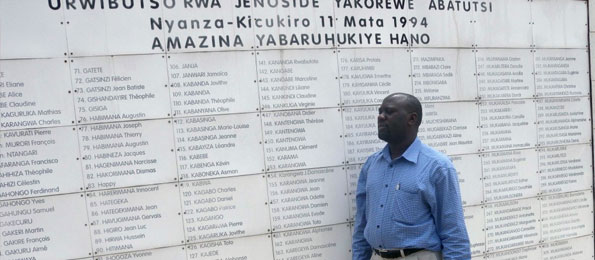Sprouting at USF Libraries: A Digital Library on Genocide in Rwanda

In the Month of October and November 2012, USF Holocaust and Genocide Studies Center (HGSC) librarian Musa Wakhungu Olaka traveled to Rwanda to digitize rare and unique documents on the genocide in Rwanda. These are documents that are currently held at IBUKA, which is an umbrella organization of associations of Rwanda genocide survivors. The digitization project took place at IBUKA’s headquarters which is located at a Nyanza-Kicukiro genocide memorial site. Most of the people buried in this memorial site were those that were removed from Ecole Technique Officielle (ETO) Kicukiro and later massacred when the Belgian soldiers stationed at ETO were recalled by their government. The recall had arisen after the Belgian soldiers guarding the then Prime Minister of Rwanda got massacred. Everyday as I got to IBUKA’s offices, the mass graves and walls inscribed with names of genocide victims reminded me of the need to digitize more documents so as to let the whole world know of the atrocities that were committed to ordinary citizens whose remains were in the mass graves and names inscribed on two wall at that memorial site. At the end of this first phase of the digitization project, we were able to retrieve 366 files from floppy disks and this translates to about 3,500 pages. 1,100 pages of magazines and journals; about 6,000 pages of reports and 823 children testimonies that translate to 9,269 pages were digitized. As a whole, we were able to digitize slightly over 16,000 pages of text using a simple DSLR camera and two laptops. All these materials will be the first batch of materials to be included in the Digital Library on the Rwanda Genocide that is going to be hosted at USF libraries. As the digital library expands, we hope to also include more materials on Genocide commemoration events; some materials on justice and the Gacaca courts; Photographs; Materials on survivors and perpetrators; mental health; Post genocide reconstruction among others. It is hoped that this digital library will grow so that it becomes one of the most comprehensive digital libraries on the Rwanda genocide. Most of the materials that were digitized are written in Kinyarwanda and a small number are in French. It is hoped that one of the added values that HGSC is proposing is to have the handwritten documents transcribed to facilitate searching and access to the materials. In case sufficient funding is available, most of the materials in Kinyarwanda will be translated so that non-Kinyarwanda speakers can be able to make more use of the materials thereby encouraging more research about the genocide and also to enable more teachers to incorporate this content in their lessons. Background work to design the digital library is currently on-going and it is likely that HGSC will use Drupal to develop and present the materials.

